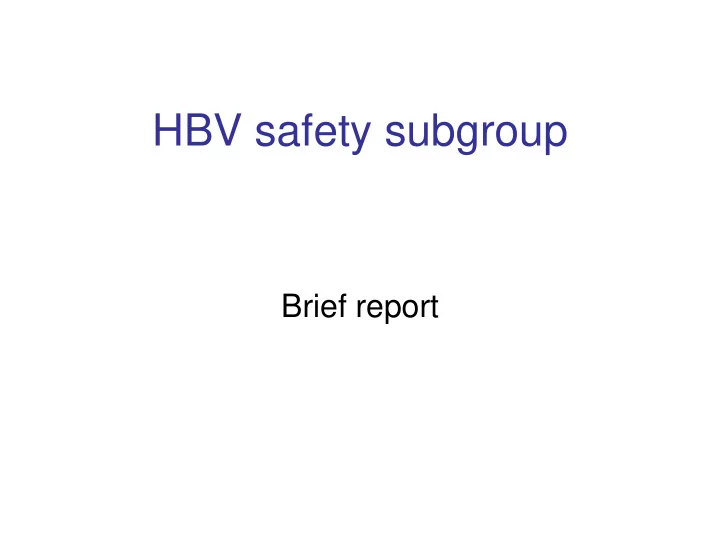

HBV safety subgroup Brief report
Main areas of new research • Mechanisms of OBI • OBI and cellular immunity • Infectivity of OBI
Mechanisms of OBI • The main advance is the change of concept that the defect in production, excretion and detection of S protein/HBsAg is a major cause of OBIs • The mutations leading to changes in RNA folding interfered with S mRNA splicing that plays a role in HBsAg production • The amino acid substitutions accumulated in the S protein MHR and extra MHR domains interfere with: • Viral replication • S protein production and export • HBsAg detection
Potential mechanisms of OBI (El Chaar, Hepatology, 2010; Svicher, Antiviral Research, 2012; Martin, J Vir Hep, 2012; Huang, J Hepatol, 2012) cccDNA Transcription OBI-specific mutations Nucleotide level Amino acid level In MHR Outside MHR Affects S RNA splicing Affects Affects Spliced HBsAg HBsAg Viral HBsAg HBsAg proteins production? detection replication excretion excretion A453G Y100S S136P D119R M75T G458A R122P Q129R P178R G463A C124R/Y G145R C137W/Y C139R C139R T140I K141E D144A D144A
OBI cellular immunity • An article was published by S Sauleda’s group: Bes M, et al. T cell responses and viral variability in blood donation candidates with occult hepatitis B infection. J Hepatol 2012;56:765-74. Results suggest that most OBIs whether or not with detectable anti-HBs are recovered infections. • A similar study is ongoing in collaboration with Drs P Manzini and P Ghiazza from Turin, Italy; Dr I Gonzalez-Fraile, Valladolid, Spain; Dr JM Garcia, Oviedo, Spain and Dr CK Lin, Hong Kong This study includes B-cell, particularly memory B-cells in addition to T-cell studies.
Infectivity of OBIs • A European collaborative study including groups from Croatia, Denmark, Germany, Poland and Spain assembled 104 patients receiving products from 24 donors (19 look back, 5 trace back) • Overall infectivity is estimated at 28% • Infectivity is dependent on: – Presence of anti-HBs in product or patient (vaccinated) P=0.013 – Volume of plasma in product (P<0.001 RCC vs FFP) – Minimum Infectious Dose 1050 copies – But not on immune status of recipients (NS) • Manuscript submitted for publication
Japanese Red Cross Study on OBI transmission according to anti-HBc level • Lookback by Satake, Tadokoro et al. presented later in this session
NAT yield samples received for confirmation and sequencing in 2011-12 Australia 3 (G Seed, Perth) Korea 2 (C Eol, Seoul) Denmark 6 (L Harritshoj, Copenhagen) Finland 3 (S Wessberg, Helsinki) Brazil 28 (P Araujo, Sao Paolo) Poland 18 (P Grabarczyk, Warsaw) Total 60
Training on HBV methods for HBV safety group collaborators • Dr Ye Xiangjin, Shenzhen Blood Centre, China • Dr Wang Wenjing, Southern Medical College, Guangzhou, China • Dr Li Tingting, Southern Medical College, Guangzhou, China • Dr Patricia Araujo, ABCS, Sao Paulo, Brazil
Recommend
More recommend